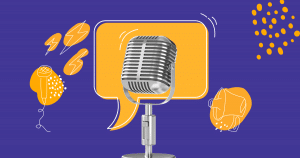Are you short on staff members and time? Do you wish you had a better content marketing strategy for your brand with more consistent posts?
Then you’ll love everything about content atomization.
While this is a somewhat older term coined by Todd Defren, it is an approach that nearly every major brand and corporation in the world uses to get more mileage out of their content marketing.
In fact, once you adopt this way of thinking, it will change the way you look at writing copy or creating videos for your website.
Here’s what you need to know about content atomization and why the process is so important to scaling your content marketing strategy.
- What Is Content Atomization?
- What Are The Benefits Of Content Atomization?
- How To Atomize Your Content?
- Examples Of Atomized Content
- The Importance Of Measuring Content Atomization
- Wrap Up: Getting The Most From Your Marketing Efforts With Content Atomization
What Is Content Atomization?
From a marketing standpoint, content atomization means taking one longer piece of content and strategically breaking it down into smaller focused pieces.
The main purpose is to try to get as much information out of a longer content piece as you can by segmenting it down into additional ideas.
For example, you might have a longer blog post about a specific topic in your niche.
Then you would create additional smaller posts regarding various frequently asked questions or side topics to what is covered on the main post.
The purpose?
To get as much effort out of your team’s research and content creation time as possible.
After all, if they are already working on the main post, then adding on the smaller segments at the same time is just as easy.
Are content atomization and content repurposing the same thing?
Simply put, they are not the same thing.
Content atomization doesn’t include taking the initial content and breaking it down verbatim, which might create a duplicate content problem for search engine optimization.
Really, it comes down to the repurposing of ideas and themes and not the content itself.
Starting with a broad topic and drilling it down into smaller, more specialized niches is a great way to take that initial idea and turn it into an entire collection of pieces that will help fill up your editorial calendar in a more efficient fashion.
What Are The Benefits Of Content Atomization?
Now that you know what content atomization entails, let’s look at the benefits and why you should be using this method.
It showcases you as an expert
When it comes to positioning your business, it is important to ensure your audience views you as an expert.
By having multiple pieces of content that follow a specific theme or collection of ideas, it gives off the impression that you know everything there is about a particular topic.
After your potential leads see that you’ve covered a particular angle in-depth and across multiple channels, this builds trust.
In the end, content atomization places you ahead of the competition that might not have a similar approach.
It is much more efficient
Creating multiple pieces of content around the same central theme is also a more efficient way to fill up your editorial calendar.
Why?
Well, if your team only has to research information once, then they’re able to churn out more pieces than if they had to spend time looking up a series of unrelated topics.
For brands with limited resources in talent or outsourcing budget, this is a key way to get more out of an initial content piece than you might have done otherwise.
In the end, atomization saves you both time and money.
Atomized pieces bring in different audiences
Depending on your niche, atomization can bring in different audiences depending on the format.
Need an example? Let’s say you’ve created:
- One long blog post.
- Six social media updates.
- A YouTube video.
- And an interactive quiz.
The person who sees the information on social media might not be the one who regularly watches video content.
And the lead who uses the online quiz might hate reading and pass on taking a look at your blog post.
See what we mean here?
Even though all of these items cover the same content, they’re reaching your target market in different ways and at different times.
This is especially important if you have a broad audience that might span multiple micro niches.
By using this strategy you can ensure you’re getting in touch with people in the method they resonate with the best and that your message reaches them more effectively.
How To Atomize Your Content?
If you’re ready to start atomizing your content, then you’re in luck.
The process itself isn’t all that difficult, but it does require a bit of thought and planning to execute efficiently.
While it is possible to take an existing piece of content and turn it into an atomized topic, it is usually better to have this type of vision from the very beginning.
Here are the best steps to follow.
Step one: decide on an overall topic
Before you can start atomizing your content, you need to decide on an overall topic.
This focus should be broad enough to fit into your general niche, but be wide enough to break down into smaller sub-topics.
This is often the area where a lot of digital marketing professionals struggle.
They want to talk about an important aspect of their industry, but they keep thinking on a micro level instead of a macro level.
Remember, you want it broad enough to be able to utilize the content in multiple ways.
To help you out, we suggest looking at areas that are of big concern to your industry or niche.
Start with the issue itself and then find ways to cover that issue.
Finally, you can devote a few pieces to solutions, frequently asked questions, or whatever else makes sense.
The main point? You want your topic to be fairly broad and offer the opportunity to go into these topics accordingly.
Step two: research the information
Once you’ve decided on what you’re going to talk about with your atomized content, start to research the information.
To make this easier, plot out one main umbrella topic and then find seven or eight smaller topics as you go.
Take notes about each one as though they were standalone topics.
However, it is important to ensure they all relate in some way. This will be important later when you actually start to produce the content itself.
If you can, try to outline various pieces that you think the information would make the most sense.
For example, you could have one sheet of paper for your primary blog and separate pieces for your smaller blogs.
While some information might carry over from one to another, the main topic of each should still be the top priority.
Step three: write the first blog post
An important thing to remember is that atomized content always starts with that first blog post.
Think of it as the basket that holds all of the topics you’ll eventually cover together in one neat package.
Feel free to touch on the subtopics you’ll cover in the future, but don’t go fully into the finer details.
Remember, that’s what your other content is for!
Be sure to make this fairly long in terms of word count, as it will make it easier to segue into other topics as you create more atomized pieces.
A good rule of thumb is anywhere between 1.000 and 2.500 words.
Step four: create smaller posts
Next, you’ll need to create smaller posts.
In most instances, a 1.500-word initial blog post could end up creating three to five smaller articles about topics covered in that first piece.
A 2.500-word post would need about seven to ten smaller pieces.
The smaller ones will be shorter, but much more pointed on what they cover.
Remember, the goal here is to give additional information that relates to what you covered in the first piece with a more in-depth viewpoint.
Think of that first article as the main summary and each of the smaller posts as chapters in the topic you’re covering.
Makes sense, right?
You can even opt to run the whole thing like a series, providing additional information with each post.
For SEO purposes, you can link to the smaller posts on the main post. This will make it easier for people to find and give you a little bonus rankings boost, too.
Step five: decide on additional content types
The coolest part about taking atomized content from written form to video, audio, or interactive media is that portions of these items can be repurposed from your initial blog posts.
A few of the most common options are:
- Guest blog post on someone else’s website.
- Downloadable whitepaper or eBook.
- YouTube video series.
- Infographic.
- Online quiz.
- Email blast.
- Podcast.
While there is no right or wrong answer to this step, it is important to think about the different people you’re trying to reach within your target audience.
Again, not everyone consumes information the same way, so it is vital to think about where you can get in front of these people most effectively.
Step six: promote on social media
Finally, you want to really niche down on your atomized content by promoting it on social media.
Take your initial piece and create several blog posts about it that you can pair with a link.
Then do the same for each piece of additional content, both written and interactive, that you’ve created.
When this is complete, you should have a solid editorial calendar with tons of great ways for your target audience to interact with your brand.
Examples Of Atomized Content
Now that you can see how atomized content works and the process of creating it, we can dive a little deeper into the process of segmenting content you’ve already finished.
Ready to look at a few examples of atomized content in action?
Let’s go.
If you have an eBook…
- Start by deciding what the overall theme is. Write your main blog post about this theme.
- Break the eBook into smaller blog posts that include various subthemes. You might even consider creating one that covers frequently asked questions about what is in the eBook.
- Create additional content that focuses on the same information, such as a video explaining the topic or an interactive quiz that relates to the same information.
- Share all of this content on social media. You could even consider leaving out just enough of the meaty information in the eBook to use your atomized content as a teaser to encourage others to download it.
If you have a podcast episode…
- Decide on the overall topic of your episode. This can be difficult in some cases, as the information might not be broad enough for true atomization. However, if it is, go ahead and write your main blog post about the theme.
- Create those smaller posts that cover the same topic (are you sensing a theme here about how to atomize your content into multiple posts?)
- Decide whether the podcast episode is broad enough to have additional content created, like a video presentation or even interactive content.
- Share all of the items by using multiple posts on your social media channels.
If you have a YouTube video…
- Just like with a podcast, you want to decide if the overall theme is large enough to segment.
- Create that initial blog post. You might even embed the video itself in the final posting on your website.
- Put together several smaller blog posts that cover ideas. Maybe a post can be the first minute of the video, and maybe the second minute of the video can be another content piece.
- Since we’re pulling at the overall theme of the video, you can opt to talk about it as a podcast episode, create a coordinating eBook or workbook, or virtually any other method that gets the same information out to a different segment of your audience.
If you have an infographic…
- Look at the overall infographic and come up with one major topic to cover and several smaller posts to create. This could mean segmenting into various areas on the graphic or even choosing smaller subtopics.
- You guessed it! Create the coordinating pieces and share them on social media.
See what we’ve done here?
Content atomization all begins with a main idea broken down into several smaller segments.
Once you’ve learned to look at your written and interactive content in this fashion, it is much easier to consistently create series of posts, videos, podcast episodes, and more.
The Importance Of Measuring Content Atomization
It isn’t all about creating tons of content and hoping for the best, right?
Content atomization is about measuring your results to see what areas your target audience is most responsive to.
Need an example?
Let’s say you’ve created one main blog post, four smaller posts, a YouTube video, and a podcast episode.
Analyze how well each one is doing before starting a second category of content.
This should give you a fairly solid idea on what types of content to pursue and which ones to skip.
The coolest part about using interactive content as part of a broader atomization strategy is that it can really give you a good idea on how your atomization is working.
Just imagine: if a video or quiz isn’t faring so well, then you might not be getting much traction on the longer blog posts.
At that point, it might be a nice strategy to brainstorm the various types of content your target customer likes to consume most and adjust accordingly.
Wrap Up: Getting The Most From Your Marketing Efforts With Content Atomization
By starting with a topic, creating a long blog post, and then coming up with smaller pieces that cover individual sections more in-depth, you can start positioning your brand or business as a true leader in your industry.
Furthermore, you can utilize different types of content to help further your efforts and increase your ability to reach different audiences.
This is a great way to reach multiple different areas of your niche and really get the most out of your campaigns.
Ready to take your content strategy to the next level? With ION, you can transform your atomized content into interactive and engaging experiences. From quizzes to immersive forms, ION empowers your marketing efforts, helping you captivate diverse audiences within your niche.
Don’t just scale your content; elevate it with ION’s innovative solutions. Explore the endless possibilities for content atomization and watch your brand ascend as a true industry leader. Curious? Test the power of ION with a 14-day free trial today!










